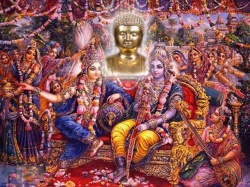Mahāvairochana Sutra
Mahāvairochana Sutra 大日経 (Skt; Chin Ta-jih-ching; Jpn Dainichi-kyō): A Chinese translation of a Sanskrit text made in 725 by Shan-wu-wei (Skt Shubhakarasimha) with his disciple I-hsing’s assistance. The Sanskrit text is unknown. It is generally supposed that the Sanskrit text dates from the seventh century. A Tibetan translation also exists. This sutra and the Diamond Crown Sutra formed the two fundamental scriptures of the True Word (Jpn Shingon) school. Tendai Esotericism added the Susiddhikara Sutra to these, forming its three principal scriptures. These became known as the three True Word sutras, following the model of the Pure Land (Jōdo) school, which had designated three Pure Land sutras.
The Mahāvairochana Sutra and the Diamond Crown Sutra respectively describe the Womb Realm and the Diamond Realm of Esoteric Buddhism. In the Mahāvairochana Sutra, Mahāvairochana Buddha explains, in a dialogue with Vajrasattva, the way of obtaining the Buddha wisdom. He defines the aspiration for enlightenment as the cause, great compassion as the foundation, and skillful means as the way to realize that wisdom. The sutra teaches that to observe the true nature of one’s mind is to obtain the Buddha wisdom. It also describes rituals and various aspects of practice, such as mudra (hand gesture), mantra (magical formula), and mandala. There are several commentaries on the text, including The Annotations on the Mahāvairochana Sutra, which is I-hsing’s record of Shan-wu-wei’s lectures on the sutra, and The Commentary on the Meaning of the Mahāvairochana Sutra, a revision by Chih-yen and Wen-ku of The Annotations on the Mahāvairochana Sutra. In Japan, True Word Esotericism adopts the former text, and Tendai Esotericism, the latter.
